|
Chiel Montagne (producer "Plastic People")
De platen van "Plastic People" werden geproduceerd door Chiel Montagne
(Bert van Rheenen).
Hij verdient hier, op deze goeddeels terugblikkende website, lots of
credits. Zonder hem zou "Plastic People" minder kansrijk zijn
geweest.
Bert had het lef Ťn het geduld om de
potentie van "Plastic People" te laten gedijen. Het loonde, want er
kwamen enkele hits uit.
Evenveel lof verdient hij door zijn innovatieve
kijk op de promotie van een popgroep die platen maakte, zeker voor die
tijd.
Voor zo ver bekend was hij de eerste in Nederland die een videoclip voor
en van een popsong maakte. Daar nam hij bovendien geen onaanzienlijk
risico mee: hij financierde de clip uit eigen middelen. Overigens was zijn videoclip van "Plastic People"
welhaast een mini-speelfilm: ze duurde niet minder dan 10 minuten!
Gek genoeg heeft "Plastic People" de videoclip van 'The Proof' destijds
zelf nooit gezien.
Want als de clip op TV werd uitgezonden, bijvoorbeeld in de toenmalige Robby Dale Show,
stond "Plastic People" meestal ergens op een toneel. Dus, mocht iemand
nog over die clip beschikken, weest dan zo goed om
eens contact met "Plastic People" op te nemen:
plasticpeople@online.nl. Bij voorbaat dank en
de band zal zijn erkentelijkheid zeker met iets stoffelijks kracht bij
zetten.
Biografie van Chiel Montage:
klik hier.
Zijn website:
klik hier. |
|
Alle songs zijn digitaal remastered. Op een aantal songs van "Plastic People" is het
Mellotron (early synthesizer) te horen, een unicum voor die periode
(1969-1971). "Plastic People" was toen een van de weinige bands die
zulke innovatieve instrumenten toepaste, al dan niet experimenteel.
|
|
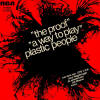 |
|
|
|
1969, "Plastic People's" eersteling
A.:
'The Proof',
B.:
'A Way to Play'
De plaat werd door velen geprezen,
mede door het mooie arrangement van Job Maarse en het strijkers
vakwerk van een team uit het Residentie Orkest. Daardoor kwam de
plaat in de Tipparade, kreeg op 20 december 1969 een hitnotering
(bron: Nationaal Pop Instituut), maar verbleef niet lang in de Top 40. |
| |
|
|
|
|
|
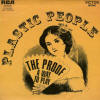 |
|
|
|
1969, "Plastic People's"
eersteling, internationaal
A.:
'The Proof',
B.:
'A Way to Play'
De plaat trok de aandacht in het
buitenland en werd vervolgens in vele landen van Europa
uitgebracht. Ze verkocht daar goed, maar werd toch niet een
echt doorslaande hit. Hier de typisch Franse hoes. |
| |
|
|
|
|
|
 |
|
|
|
1970, "Plastic People's" tweede
single
A.:
'To Margie',
B.:
'Rejection'
'To Margie' werd gezongen door leadzanger Peter Engel. 'Rejection' door tweede leadzanger Wijnand Kors.
'To Margie' kwam min of meer tot stand als een jam session.
Duidelijk hoorbaar is de bijdrage van Jan Akkerman op sologitaar; hij was
bij toeval in Studio GTB in Den Haag aanwezig. De plaat deed
desondanks weinig. |
| |
|
|
|
|
|
 |
|
 |
|
1970, "Plastic People's" derde
single: een hit !
A.:
'Dancing and Drinking',
B.:
'Rejection'
'Dancing and Drinking'
kreeg direct na uitkomen een hitnotering (7 november 1970), werd Alarmschijf en kwam kort nadien in de Top 40.
Opvallend is de B. kant met een instrumentale versie van het
eerder uitgekomen 'Rejection'. Dat nummer werd vooral in BelgiŽ
gewaardeerd en was daar een discotheek hit rond Kerst en Nieuwjaar
1970 en 1971. |
|
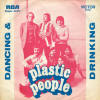 |
|
 |
|
'Dancing and Drinking'
werd niet alleen in Nederland een hit,
maar ook in ItaliŽ (hoes hierboven, 2e van links), Portugal (1e
hoes, links), Spanje (2e hoes, links) en andere Europese landen.
De foto's voor de hoezen werden gemaakt door Claude Vanheye,
toen een jonge veelbelovende popfotograaf, en die belofte is meer dan uitgekomen. |
| |
|
|
|
|
|
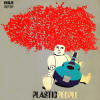 |
|
 |
|
1971, "Plastic People"
LP 'Plastic People'
1.
Song to an unknown girl
2.
Take it easy
3.
Girl in the coffeeshop
4.
The Ashtonishing vicissitudes of Billy
5.
Why did she go (she didn't have to...)
6.
The place of Crazy Daisy
7.
The destruction of Riverside, Colorado (USA)
8.
I would like to know
9.
Goodbye
Het voortreffelijke
hoesontwerp was van Raymond van Geytenbeek. Zijn tijdloze artistieke
vertaling van het begrip Plastic People was en bleef het handelsmerk van
de band
"Plastic People". |
| |
|
|
|
|
|
 |
|
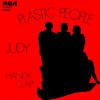 |
|
1971, "Plastic People's"
vierde single
A.:
'Judy',
B.:
'Handy Clap'
De plaat was bedoeld als opvolger van het succesvolle 'Dancing
and Drinking'. Het had evenwel minder. Desondanks kreeg 'Judy' op 20 februari 1971 een hitnotering en stond korte
tijd in de Tipparade en Top 40.
De foto voor de hoes werd eveneens gemaakt door Claude Vanheye. |
| |
|
|
|
|
|
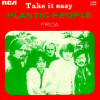 |
|
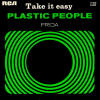 |
|
1971, "Plastic People's"
vijfde single
A.:
'Take it Easy',
B.:
'Frida'
'Take it Easy' stond op de LP 'Plastic People' en
werd als single uitgebracht. Hoewel de LP 'Plastic People' zich
mocht verheugen in goede verkopen, gold dat minder voor de single
' Take it Easy', ondanks haar hitnotering op 4 september 1971.
De foto voor de linker (Nederlandse) hoes kwam weer uit de
camera van Claude Vanheye, deze maal geschoten in het
Amsterdamse Vondelpark. De rechter hoes zat om de Europese
release van de plaat. |
| |
|
|
|
|
|
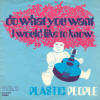 |
|
|
|
1973, "Plastic People's"
zesde en laatste single
A.:
'Do What You Want',
B.:
'I Would
Like to Know'
Deze plaat is volgens insiders vergaand onderschat. Misschien is
dat waar, ze had vrijwel gelijke potentie als de hit 'Dancing and Drinking'. Maar feit blijft dat de plaat om nooit verklaarde
redenen niet op de zenders werd gedraaid en dus geen hit kon
worden zoals verwacht. Je kan het daarom de Zwanenzang van "Plastic People"
noemen, want nog geen jaar later viel de band uiteen en stopte
definitief. |
| |
|
|
|
|
|